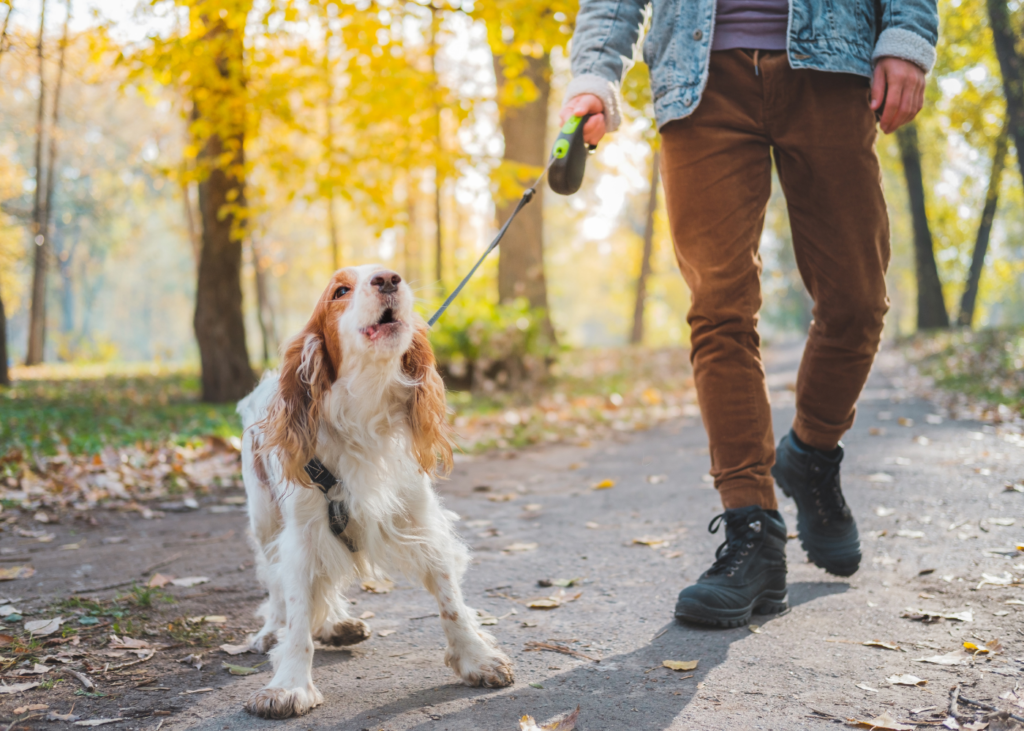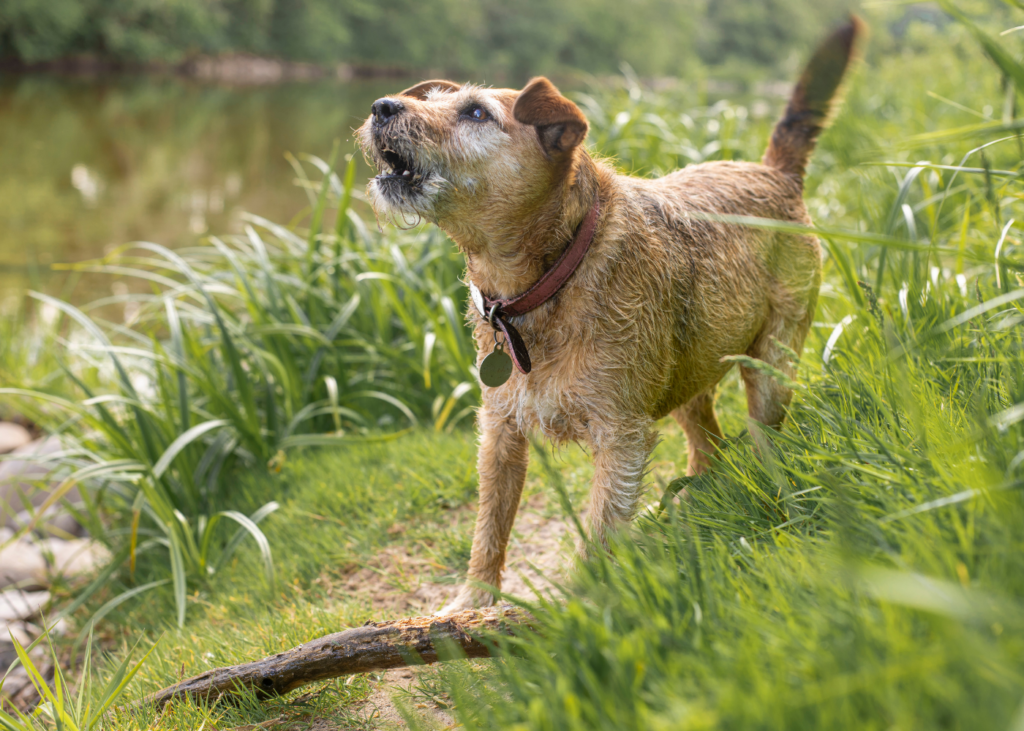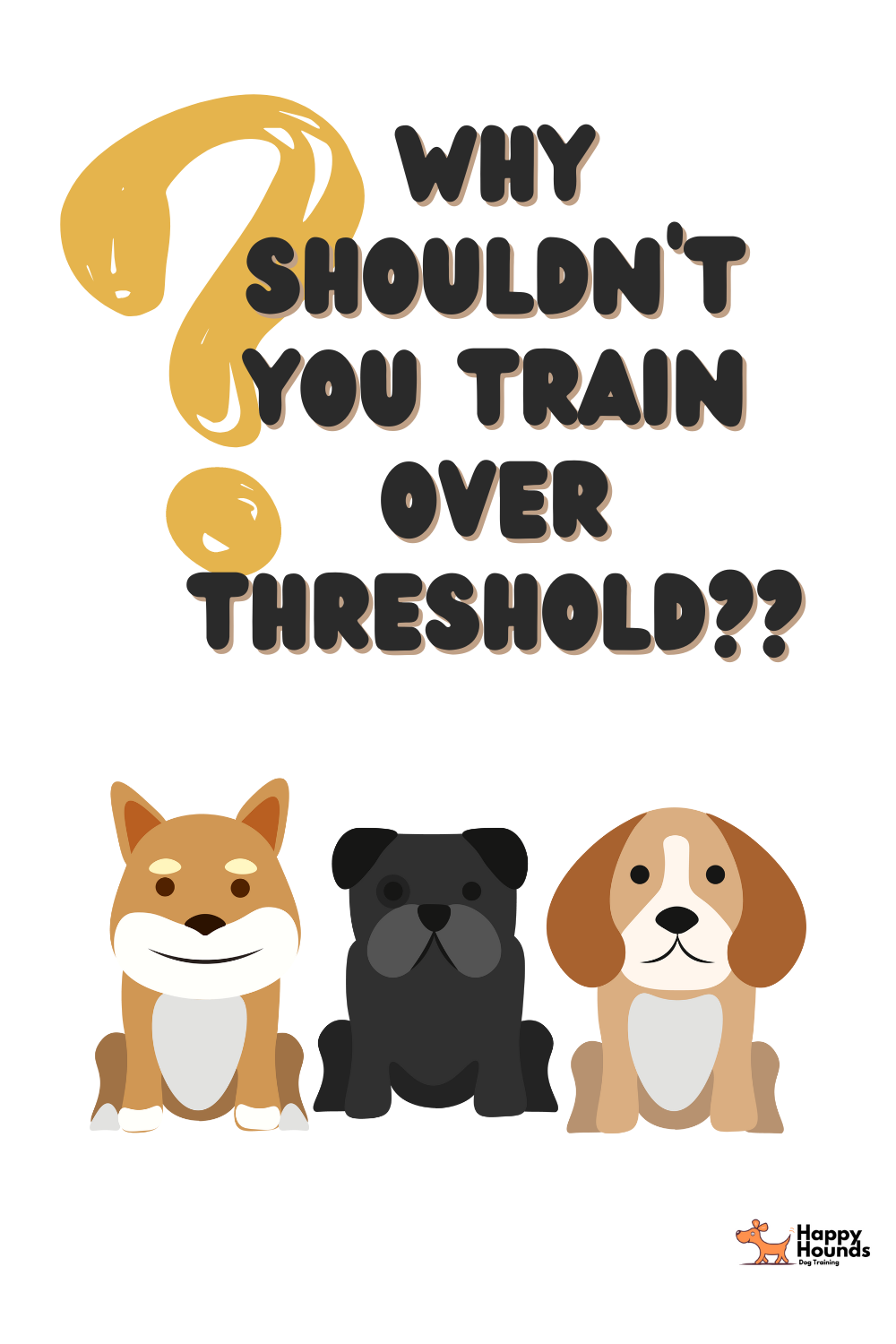Has your dog ever “lost it”? They were seemingly fine one minute, then began barking, lunging, growling, or completely shut down the next minute? It’s likely you found yourself in a situation where your dog’s threshold was exceeded.
What does that mean, and why should you care?
Threshold is a very important term in dog training, so let’s discuss!
If you prefer video explanations, watch THIS. I think it’s one of my most entertaining Youtube videos 😉

In this article we will cover:
- What is a dog’s threshold?
- How does a dog appear when they’re over threshold?
- Why can’t you train a dog when when they are over threshold?
- Why you should never punish a dog for going over threshold
- What affects threshold?
- What should you do when your dog goes over threshold?
What is a dog’s threshold?
The definition of dog threshold is the point where a trigger (a dog, child, situation, etc) is strong enough that the dog notices it, but not yet strong enough to cause an emotional reaction. Over threshold is exactly as it sounds: the trigger is strong enough that the dog is now in distress and reacting rather than thinking.
Try to think of it like a door threshold: When you cross a threshold you cross from one area to another (inside to outside, for example).

For a dog’s threshold, you’re instead moving from one emotional state (dog is emotionally coping) to another (dog is no longer coping).
How does a dog appear when they’re over threshold?
It’s a common misconception that when a dog goes over threshold they will always be barking, lunging, or growling.
To be fair, these reactive behaviours are the ones most commonly seen and noticed by pet parents. They ARE a sign a dog is over threshold.
Other signs a dog is over threshold include:
- Disinterest in treats (from a dog that commonly likes that treat) OR taking treats frantically (when out of character for that dog)
- Freezing
- Intense over excitement (mouthing, jumping, zooming around in a frantic manner)
- Your inability to get your dogs attention with methods that typically work
Dogs are individuals and display distress differently, so each dogs “over threshold” will look different!
I often try to get my clients to think of threshold as the dogs personal bubble. Think of yours! There’s a distance someone can be from you where you’d barely even notice them, a distance from you appropriate for comfortable conversation, and a distance that is WAY too close. How we respond when someone is in our face varies. You may vocalize your discomfort with the person being in your bubble, you may push them away, or you may freeze because you’re uncomfortable.
Or another way to think of it: some people scream in terror on rollercoasters; others can’t make noise even if they try.
We respond differently to the same stimulus.
Just like there’s variations in human reactions, dogs react differently when over threshold too!

Why can’t you train a dog when they are over threshold?
When a dog is over threshold, they are in distress.
I’m scared of spiders, so I often use them in my analogies with clients. Let’s do that.
Let’s say you want to teach me a math equation. Ok. You want to do so while a spider is in the house.
If that spider is far enough away, I can still focus on what you’re saying; I can learn. I’m not over threshold. I’m AWARE of the spider, but not having an emotional response to it.
Now, what if you put that spider on my head?!?
I’m instantly over threshold and no longer able to think clearly; I’m simply reacting at that point.
Imagine as I’m flailing around trying to get it off, you explain the math equation to me.
How much of what you said do you think I’ll remember and have learned?
Literally none.
My brain was consumed by the emotional response to having a spider on my head, so no learning is happening!!
Dogs are no different. When a dog is over threshold it is NOT the time to try teaching them.
Why you should not punish a dog for going over threshold:
Occasionally after I’ve given that analogy to clients, one might point out that they have watched dog training shows such as Cesar Millan and a dog WAS trained while over threshold. This is actually called suppression, and it’s a bad idea.
Let’s watch a terrible video example of Cesar punishing and “training” a dog for resource guarding as an example of how punishment suppresses (temporarily) the dogs response. Since it does not address the underlying emotion of the dog, the dog stops growling but instead bites.
(Warning- this video contains both a dog bite and dog abuse)
If you know ANYTHING about canine body language, you can clearly see the dog was far from relaxed when Cesar claimed that it was. The following bite was highly predictable, not surprising.
[Resource guarding is a dangerous but completely normal behaviour. Read this article for a full explanation of resource guarding, including why Cesar Millans approach is the exact opposite of what you SHOULD do if your dog guards]
So why shouldn’t you punish your dog for going over threshold?
When your dog is over threshold and therefore reacting accordingly, they aren’t choosing to “be bad”. They’re having an involuntary emotional response.
Think of it like the former spider on my head analogy. You might freeze with terror if that happened to you. Me however? I’m going to cuss and flail and run around like a crazy person trying to get it off. If I say something that upset you, or even hit you as I flail, they weren’t intentional actions. My body was reacting, not thinking.
If you somehow punished me to the point of shutting down while the spider was on my head, you have suppressed my response but NOT the emotions I’m feeling. I remain terrified of that spider, even if I’m not allowed to show it.
A dogs reaction while over threshold is them showing they cannot handle the situation they are in. Punishment may prevent them from SHOWING their emotion, but does not actually improve their emotional state.
Punishing a dog’s response to going over threshold is like taking the batteries out of a smoke detector during an active fire and thinking “fixed it!”. No, you did not. You only turned off the warning signal. The fire is still very much there.
Trying to train or punish a dog over threshold might create what people see as “entertaining tv”, but it isn’t proper dog training!

What affects threshold?
Let’s continue with the spider fear analogy. Are all spiders created equally? No. Will all interactions with spiders produce the same response? Also no. Why?
Is a tiny spider going to cause as much panic as a dinner-plate-sized one?
Will a spider across the room scare you as much as one on your face?
Would a cluster of spiders gross you out more than just one?
Just like you, there are aspects that will affect whether a trigger pushes a dog over threshold such as:
(Let’s assume other dogs are a trigger as an example)
- How many: Walking past one dog will be less stressful than 7!
- Intensity: Big dog walking past, or small? Is the other dog ignoring your fearful dog or barking at them?
- Distance: This affect is VERY important!! It’s the one we often manipulate during reactivity training (when we do not want a dog over threshold). How far away the trigger is from the dog has a tremendous affect on threshold.
- Duration: How long is your dog exposed to their trigger. Did the other dog jog right past, or are they in your dogs view for 10 minutes?
- Frequency: Does your dog get a break to calm down between triggers, or do dogs repetitively keep walking past?
- Physical and emotional state: Discomfort, thirst, hunger, pain, etc can all make your dog more likely to go over threshold
- Trigger stacking: Seemingly independent stressors building up to a tipping point. This one is important enough to understand that I wrote a separate blog post about it! (Read it here)
What should you do when your dog goes over threshold?
The more aware you are of your dogs triggers the more you can manage them (and therefore your dogs threshold). However, life happens and there are going to be times outside of your control.
What should you do if your dog does go over threshold?
- Recognize that at best this is a learning opportunity for you, but it is NOT an opportunity to train your dog! Therefore:
- Leave the situation quickly! Remove your dog from whatever situation pushed them over threshold as fast as you can.
- Assess & reflect on what happened. Can you recognize what caused the reaction? Were there more subtle stress signals your dog was showing that perhaps you hadn’t noticed? Was it trigger stacking? Play detective and make a plan for next time!
- If your dog is going over threshold often and you can’t seem to puzzle together why, find a force-free dog trainer in your area to work with.
Happy training! 🙂
Disclosure: Happy Hounds uses affiliate links. Purchasing with these links will not cost you any extra, but I get commissions for purchases made through these links. Affiliate links help me to continue to offer free resources & blog posts. I would love if you used them!


+ show Comments
- Hide Comments
add a comment